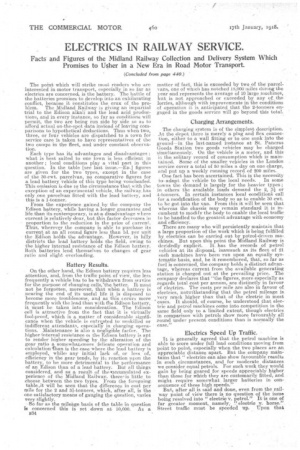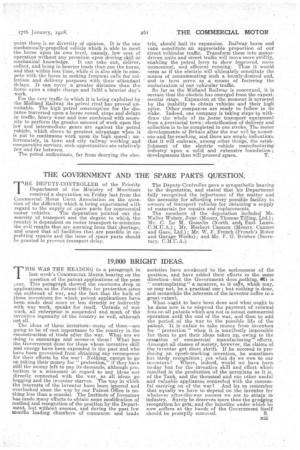• ELECTRIC S IN RAILWAY SERVICE.
Page 12

Page 13

If you've noticed an error in this article please click here to report it so we can fix it.
Facts and Figures of the Midland Railway Collection and Delivery System Which Promises to Usher in a New Era in Road Motor Transport.
(Concluded from page 440.)
The point which will strike most readers who are, interested in motor transport, especially in so far as electrics are concernext, is the battery. The battle of the batteries promises to develop into an exhilarating conflict, because it constitutes the crux of the problem. The Midland Railway is giving an impartial trial to the Edison alkali and the lead acid productions, and in every instance, so far as conditions will permit, the two are being run side by side so as to afford actual on-the-spot data instead of leaving comparisons to hypothetical deductions. Thus when two, three, or four vehicles are dispatched to a town for service care is taken to have representatives of the two camps in the fleet, and under constant observation.
Each type has its advantages and disadvantages ; what is best suited to one town is less efficient in another ; local conditions play a vital part in this question. In the table [see last issue.—En.] figures are given for the two types, except in the case of the 30-cwt. pareelvan, no comparative figures for a lead battery. vehicle of this type being voucheaf ed. This ornissionra due to the circumstance that with the exception of an experimental vehicle, the railway, has only one parcelvan fitted with the lead battery, and this Tis a 1-tonner.
From the experience gained. by the company the Edison battery ; while having a longer guarantee and life than its contemporary, is at-a disadvantage where current is relatively dear, but this factor decreases in proportion to the reduction in the price of current. Thus, wherever the company is able to purchase its current at an all round figure less than ld. per unit the .Edison holds the advantage. However,, in hilly districts the lead battery holds the field, owing to the higher internal resistance of the Edison battery. Both batteries lend themselves to changes of gear ratio and slight overloading.
Battery Results. •
On the other hand, the Edison battery requires less attention, and, from the traffic point Of view, the less frequently a vehicle has to be withdrawn from service for the purpose of changing cells,'the better. ft must not be forgotten, moreover, that when a battery is nearing the end of its useful life it is disposed to become more troublesome, and as this eocurs mere frequently with the lead than with Che Edison battery, it must be taken into consideration. The -Edison cell is attractive from the fact that it is virtually fool-proof, which is a matter of considerable ,significance when the vehicle is entrusted tounskilled or indifferent attendants, especially' in charging operations. Maintenance is also a negligible facCor. The higher internal-resistance as the Edison battery is apt to render higher speeding by , the alteration of the gear ratio a somewhatamore aelicate operation and calculation 'than is the caae-where the lead battery is employed, while o any initial lack of, or loss of, efficiency in the gear tends, by its reaction upon the battery, to be more detrimental to the performance of an Edison than of a lead battery. But all things considered, and as a result of the 'accumulated experience of flit; Midland Railway. there is little to choose between the two types. From the foregoing. table.it will be seen that the difference in cost per mile for the 2 and 4-tonners, which, 'after all, is the one satisfactory Means of gauging the question, varies
very slightly. • Solar as the mileage.basis of the table in question is concerned this is set down at 10,000. As a B34
matter of fact, this is exceeded by two of the parcelvans, one of which has notched 18,000 miles during the year and represents the average of 10 large .maehines, hut. is not approached or exceeded by any of. the lorries, although with improvements in the conditions of operation it is anticipated that the 2-tormers engaged in the goods service will go beyond this total.
Charging Arrangements.
• The charging system is of the simplest description. At the depot there is merely a plug and flex connection, either to a wall fitting or to one sunk into the ground—in the last-named instance at St. Pancras Goods Station two goods vehicles may be charged simultaneously. On the vehicle is a meter, and this is the solitary record of consumption which is maintained. Some of the smaller vehicles in the London service cover a total of 50 miles a, day on one charge, and put up a weekly running record of 200 miles.
One fact has been ascertained. This is the necessity
to adapt the vehicle, to the local needs. In some towns the de-mand is largely for the heavier types ; in others the available: leads demand the 2, 3 or 4-tenners. In certain instances local condition A call for a modification of the body so as to enable 30 cwt. 10 be got into the van. From this it will be seen that whereas the chassis may remain standard it is incumbent to modify the body to enable the local traffic. to be handled to the greatest advantage with economy and efficiency.
There are many who will persistently maintain that a large proportion of the work which is being fulfilled by electrics can he carried out by petrol-driven, ma-. chines. But upon this point the Midland Railway is decidedly explicit. It has the records of petrol vehicles at its disposal, inasmuch as its fleet of 21 such machines have been Tun upon an equally systematic basis, and, be it remembered, that so far as fuel is ooncerned, the company holds a distinct advantage, whereas current from the available generating station iS charged out at the prevailing price. The company declares that "the. figures, more especially as regards total cost per annum, are distinctly in favour of eleatrics. The" costs per mile are also in favour of electrics, notwithstanding that the petrol mileage is very much higher than that of the electric in most cases. It should, of course, be understood that electric and petrol machines come into competition in the same field only to alimited 'extent, though electrics in comparison with petrols show More favourably all round under present conditions than is normally the case."
Electrics Speed Up Traffic.
It is generally agreed that the petrol machine is able to score under full load conditions moving from point to point, especially when the two places are an appreciable' distance apart. But the .company maintains that " e.loctries can also show favourable results in such circumstances, and for -moderate distances we consider equal petrels. For such work they would gain by being geared for speeds appreciably higher than those for .which they are customarily fitted,and might require somewhat, larger batteries in consequence of these high speeds."
But, after all is said and done, even from the railway point of view there is rio question of the issue being resolved into " electric v. petrol." It is one of far greater moment, namely,. electric .v. horse." Street traffic must be speeded up. Upon that
point there is no diversity of opinion. It is the one mechanically-propelled vehicle which is able to meet the horse upon its. own level, namely, low cost of operation without any premium upon driving skill or
mechanical knowledge. It can take out, deliver, collect, and bring in heavier loads than can the horse, and that within less time, while it is also able to compete with the horse in making frequent calls for collection and delivery purposes with their attendant delays. It can cover . a greater distance than the horse upon a single charge and fulfil a heavier day's work.
For the very traffic in which it is being exploited by the Midland Railway its petrol rival` has proved unsuitable. The high petrol consumption for the distance traversed upon a horse round stops and delays in traffic, heavy wear and tear combined with necessity to perform the greater amount of w-ork upon the low and intermediate gears are against the -petrol vehicle, which shows to greatest advantage when it is put to Continuous work upon its high speed ; unfortunately, in town and city railway working. and comparative services, such opportunities are relatively few and far between.
The petrol .enthusiasts, far from decrying the elec trio, should hail its expansion. Railway horse and vans constitute an appreciable proportion of our street vehicular traffic. Transform these into motordriven units and street traffic will move more swiftly, enabling the petrol lorry to show improved, more economical, and efficient running. Thus it would seem as if the electric will ultimately constitute the means of consummating such a, keenly-desired end, and in turn serve as a means of fostering the motorization of our vehicular traffic.
So far as the Midland Railway is concerned, it is certain that the electric has emerged from the experimental stage, Expansion at the moment is arrested by. the inability to obtain vehicles and their high price. Other companies are ready to follow in its wake. Indeed, one company is taking steps -to withdraw the whole of its .horse transport equipment from a provincial town: electrification of delivery and collection is to be completed in one stroke. The motor developments of Britain after the war will be numerous and far-reaching, and there are ample indications that it will embrace, among other things, the estahlishment of the electric vehicle manufacturing industry upon a solid and extensive foundation ;
developments then will proceed apace. T.
























